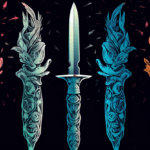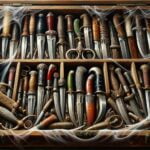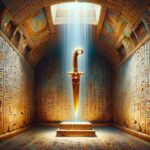Step into the enchanting realm of literature and prepare to be captivated by the allure of famous fictional daggers. In this riveting article, we will embark on a thrilling journey through the pages of timeless tales, unraveling the mysteries surrounding these legendary blades. From ceremonial relics to instruments of destiny, these daggers have left an indelible mark on the literary landscape. Prepare to be enchanted, as we delve into the enigmatic might of these renowned fictional treasures, unearthing their hidden secrets and unveiling the legends that surround them.
Famous Fictional Daggers
Daggers have long captivated our collective imagination, their iconic designs and rich symbolism making them a prominent feature in both historical accounts and iconic works of fiction. From the menacing Witch-king’s Dagger to the noble Glamdring, these legendary blades have left an indelible mark on the realm of literature and art. Join me as we embark on a journey to unveil the secrets and significance hidden within the legends of famous fictional daggers.
Mysterious Origins and Cultural Impact
Like whispers in the night, the origins of these famous fictional daggers are often shrouded in mystery. Take, for instance, Merlin’s Dagger, said to possess mystical powers and imbued with the essence of ancient magic. This legendary weapon symbolizes wisdom and possesses the power to alter destinies. It is a testament to the enduring appeal of daggers and their ability to enrich the narrative fabric of tales.
Historically, daggers have been associated with pride, courage, and wealth. They were crafted to be swift and deadly, designed specifically for stabbing. In wars, daggers served as elegant symbols of honor and were proudly brandished by warriors. Today, they continue to captivate our fascination, with famous daggers like the Khopesh garnering attention for their distinctive hook-shaped blades and their association with the Bronze Age.
Metaphorical Catalysts in Fiction
Famous fictional daggers not only serve as physical weapons within the stories they inhabit, but also act as metaphorical catalysts, propelling pivotal plot points forward. Consider the enigmatic Dagger of Thulsa Doom, a relic of ancient power that serves as a totem of nefarious deeds and treachery. Its sinister presence sparks a chain of events that drives the narrative of Conan the Barbarian, highlighting the dagger’s role as both a tool of destruction and a symbol of corruption.
In the realm of fantasy, the Dagger of Rostam represents ancestral strength and honor. Passed down through generations, this fabled weapon becomes a central motif in epic tales, embodying the enduring legacy of heroism and sacrifice. The tale of a hero’s quest is incomplete without the legendary dagger, its mythical power adding depth and intrigue to the story.
Types of Daggers: A Closer Look
Daggers come in various forms, each with its own distinct characteristics. Let’s delve into some notable types of daggers:
-
Dirk: A traditional Scottish dagger, the dirk combines elegance and functionality. With its sharply tapered blade and ornate hilt, the dirk is synonymous with Scottish heritage and military prowess.
-
Hunting Dagger: The hunting dagger, with its robust blade and fortified crossguard, is a weapon designed for survival in the wilderness. This practical tool harks back to a time when the hunt was a matter of survival, evoking a sense of self-reliance.
-
Parrying Dagger: As its name suggests, the parrying dagger is specifically designed for defense, with a double-edged blade and a large protective guard. It is a testament to the ingenuity of craftsmen, who sought to create a weapon that would complement a primary sword.
-
Sgian-dubh: This Scottish dagger, worn as part of traditional Highland dress, embodies both cultural significance and utilitarian purpose. Concealed discreetly in the sock, the sgian-dubh symbolizes personal protection and heritage, while also serving as a versatile tool.
Famous fictional daggers draw inspiration from these types, weaving intricate narratives and adding depth to the stories they inhabit.
Unveiling the Enigmatic Might
The legends surrounding famous fictional daggers are woven into the fabric of our literary landscape, their allure captivating generations of readers and enthusiasts. From their mysterious origins to their metaphorical significance, these weapons offer tantalizing glimpses into the depths of human imagination. As we peel back the layers of their tales, we discover the indomitable spirit of courage, the allure of power, and the enduring resonance of these legendary blades.
So come, join me on this journey as we delve deeper into the secrets and significance behind famous fictional daggers. Let us unlock the enigmatic might that lies within, exploring the worlds where these iconic weapons have left an indelible mark.
“The stories of famous fictional daggers are intricately intertwined with the human experience, blending history, symbolism, and the boundless realms of imagination.”
Famous daggers have a long and storied history. From the legendary Excalibur to the mysterious Dagger of Time, these weapons have captured the imaginations of people throughout the ages. If you’re curious to learn more about these iconic daggers and the legends behind them, click here for a fascinating collection of stories and insights. Let your curiosity guide you into the world of famous daggers: famous daggers.
Top 10 Mythical Swords: Unveiling the Legends
[youtube v=”9P8N-W7dPT0″]
All About Mythical Swords
Daggers have long captivated the human imagination, their allure appearing in historical accounts and fictional tales alike. These legendary blades not only possess mysterious origins but also have a profound cultural impact. Mythical swords evoke a sense of pride, courage, and wealth, and their stories transcend the realm of physical weapons, serving as metaphorical catalysts in captivating narratives. In this article, we delve into the world of mythical swords, exploring their history, symbolism, and the imaginative legends that surround them.
1. All Fiqar: The Scimitar Descended from Heaven
Originating in the Middle East, All Fiqar holds a place of iconic significance. Believed to have been brought down from heaven by the Lord of Angels, Gabriel, this scimitar was bestowed upon Muhammad and later passed on to his cousin, Ali ibn Abi Talib. Known for its scissor-like appearance, the unique split tip and jagged blade of All Fiqar have made it a symbol of power and greatness. As the inscription on other swords bears its name, All Fiqar’s legendary status is indisputable.
“All Fiqar, the scimitar descended from heaven, possesses an undeniable aura of power and greatness.”
2. Dandaka: The Sword Associated with Knowledge
Dandaka, a sword belonging to the Hindu god Vishnu and his avatars, derives its name from “source of joy,” which is fitting for a weapon with a significant association with knowledge. Vishnu wields this sword to cut through the darkness of ignorance, making it both a physical and symbolic tool. It is said that a few strikes of Dandaka can dispel any exam-related troubles, providing a glimpse of the power this mythical sword symbolizes.
“Dandaka, the sword associated with knowledge, offers a glimmer of hope in the face of academic challenges.”
3. The Sword of Attila: Scourge of God
When Attila the Hun, known as the “Scourge of God,” acquired an awe-inspiring sword, his reputation for fear and dominance reached new heights. According to legend, this legendary blade was discovered by chance when a shepherd found it after a sheep accidentally stepped on it. Immediately recognizing it as the “sword of God,” Attila embarked on his conquest of Europe, instilling fear in the Roman Empire’s crumbling remains.
“The Sword of Attila, a symbol of unstoppable power, propelled the Hunnic ruler to conquer Europe.”
4. Gram: Saga of Sigmund and Odin
The legendary sword Gram belonged to Sigmund, a prominent figure in the Norse Saga, Sunka Saga. During Sigmund’s sister’s wedding, a stranger appeared and thrust his sword into the trunk of a tree, thus capturing the attention of all. To everyone’s surprise, this stranger turned out to be none other than Odin, the Norse god. Odin declared that whoever could remove the sword would become its rightful owner and destined for victory. Only Sigmund succeeded in pulling the sword free, later passing it down to his son, Z Sigurd, who used it to slay the dragon, Fafnir.
“Gram, the sword of destiny and victory, played a pivotal role in the Norse saga, Sunka Saga.”
5. Shamsher: Persia’s Enigmatic Epic
In the Persian epic, “Izumo Nagar Amir Arsalan,” the legendary Shamsher takes center stage. The protagonist, Amir Arsalan, faces numerous challenges, including a fierce and supposedly invincible horned demon. This demon can only be defeated by a sword considered to be incredibly valuable and said to have belonged to King Solomon himself. Legends claim that even the slightest nick from this mighty blade meant death, making it a symbol of terror guarded closely by the demon.
“Shamsher, the sword of terror and legacy, cautions against underestimating its mythical power.”
6. Joyeuse: The Sword of Charlemagne
In the legends surrounding the renowned Holy Roman Emperor Charlemagne, Joyeuse claims a prominent place. This illustrious sword boasts a unique connection to history as it is said to contain a part of the same spear that pierced Jesus during his crucifixion. Infused with tales of its ability to blind enemies and turn different colors, Joyeuse captures the imagination. If only the soldiers of the Middle Ages had sunglasses to shield themselves from its brilliance.
“Joyeuse, the sword radiating iridescent power, ignited fear in the hearts of Charlemagne’s adversaries.”
7. Hanzo Masamune: The Legendary Rivalry
Japanese history reveres Masamune, widely considered the greatest swordsmith, and his rivalry with his pupil, Muramasa. Legend has it that Muramasa’s blades were cursed, designed for deadly purposes, while Masamune’s swords only cut what deserved to be cut. The Honjo Masamune, one of Masamune’s finest accomplishments, became synonymous with the Shogunate during the Edo period. Designated a Japanese national treasure, this extraordinary blade sadly vanished after World War II.
“Hanzo Masamune, a testament to the rivalry between two legendary swordsmiths, embodies the essence of Japanese sword craftsmanship.”
8. The Glory of Ten Powers: Magic Born of Love
According to Chinese literature, the Glory of Ten Powers is a sword imbued with the magic of love. Crafted by Tibetan magicians who adhered to the teachings of Tonpa and Rab Me Woosh, this sword embodies their great spiritual love. It is said that a deity infused the sword with immense magical powers, striking fear in the hearts of its wielder’s enemies. Eventually captured, the sword was burned and transformed into a powerful talisman.
“The Glory of Ten Powers, a sword forged from boundless love, holds unimaginable magical abilities.”
9. Kusanagi: The Grass-Cutting Sword
Known originally as the Heavenly Sword of Gathering Clouds, Kusanagi’s origin story traces back to ancient legends. When Zeus Anu, a god, aided a grieving family by slaying a fearsome serpent, Susanoo discovered this legendary blade hidden within it. Subsequently gifted to Yamato Takeru, who used it to escape an ambush, this remarkable sword exhibited control over the wind. Renamed Kusanagi, the Grass-Cutting Sword, its power and significance endure.
“Kusanagi, the enigmatic Grass-Cutting Sword, weaves together tales of divine intervention and legendary escapes.”
10. Excalibur: The Iconic Sword of King Arthur
No repertoire of mythical swords can be complete without Excalibur, the legendary blade of King Arthur. Boasting numerous mystical powers and often associated with the Sword in the Stone, Excalibur’s name derives from the Welsh words for “hard cleaver.” According to legend, the Lady of the Lake bestowed Excalibur upon King Arthur at the beginning of his reign. Its radiant blade, capable of blinding enemies, bears the inscriptions “take me up” and “cast me away.” Excalibur’s scabbard is also said to possess unique protective abilities against blood loss.
“Excalibur, the legendary sword of King Arthur, stands as a symbol of nobility, power, and mythical grandeur.”
In conclusion, mythical swords captivate our imagination, weaving tales of power, destiny, and magical abilities. From All Fiqar’s celestial origin to Excalibur’s association with King Arthur’s legacy, these legendary blades continue to hold us under their enchanting spell. So, dive into the realm of mythical swords and let their timeless stories inspire your imagination.
FAQ
Q: What are some famous fictional daggers?
A: Some of the most famous fictional daggers include Glamdring, Witch-king’s Dagger, Dagger Claw Sword, Strider Dagger, Riddick Claws, Dagger of Thulsa Doom, and Merlin’s Dagger.
Q: What is the significance of daggers in wars?
A: Daggers were designed for stabbing and were used in wars to showcase pride, courage, and wealth.
Q: What are some different types of daggers?
A: Some different types of daggers include the Dirk, Hunting dagger, Parrying dagger, Sgian-dubh, Trench knife, and Push dagger.
Q: What is the difference between daggers and knives?
A: Daggers and knives are both capable of stabbing, but daggers were specifically designed for stabbing.
Q: What are some famous fictional daggers besides the ones mentioned?
A: Some other famous fictional daggers include Carnwennan, Dagger of Rostam, and Mjolnir.
- Unraveling Einstein’s Legacy: Who Inherited His Genius? - July 14, 2025
- Unlock Einstein’s Family Tree: Bernhard Caesar & Untold Stories - July 14, 2025
- Unveiling Bernhard Caesar Einstein: His Life & Albert Einstein’s Legacy - July 14, 2025
















